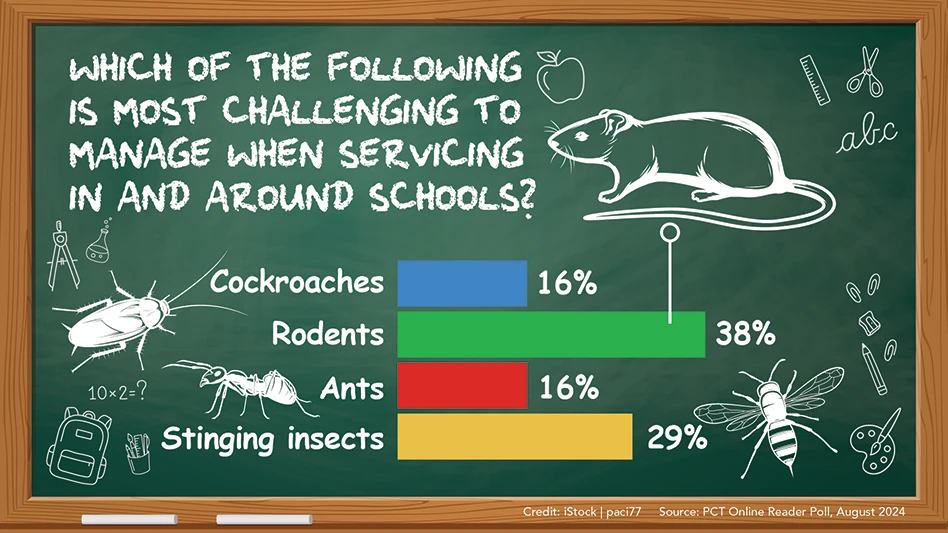
CLEVELAND – Providing pest control in schools presents its own set of challenges. Rodents, in particular, require extra attention. Thirty-eight percent of those who responded to PCT’s recent reader poll said rodents were the most challenging pest at schools, while another 29 percent said stinging insects presented the greatest challenge.
One of the reasons schools can be a complicated setting is because they have so many areas where rodents can go undetected, according to Bennett Jordan, Ph.D., B.C.E., staff scientist, Ecolab. “The grounds themselves could be harboring rodents, providing the conducive conditions necessary to support rodent activity. Then you layer on all the considerations of an active school that has many hundreds of students, teachers and faculty, and they have opinions, sensitivities, things to watch out for. It adds to what is already the difficult situation of solving the problem itself.”
Jeff White, owner of White Mantis Consultants and partner in Rest Easy Pest Control (N.J., N.Y.), said rodent control can be particularly challenging in urban schools, many of which are older structures. “There can be a million different entrance holes in these type of buildings, so the pest control solution can be very time-consuming and outside of what a school has budgeted to spend on pest control,” White said.
Rodent control in schools is heavily dependent on exclusion and the use of mechanical traps, and “a lot of those efforts can be very manual in nature and time is money,” said White. “It might not be in a school’s budget to have someone on site every week to check snap traps. So, you have to train maintenance staff to help out, and that can get complicated.”
As with other types of accounts, communication is critical, White said. “In New Jersey, the schools have to have an IPM coordinator and they have to be communicating with the pest control company. Everybody in the school base needs to understand what the rules are when it comes to pest control, and then you need to obviously have a strong IPM program implemented. It's the age-old adage that everyone needs to be on the same page when it comes to communicating.”
Twenty-nine percent of those who responded to PCT’s reader poll said stinging insects were their greatest challenge at schools. Ecolab’s Jordan said schools include children, staff and faculty who know they are allergic to stings, as well as those who aren’t aware they are allergic. “You want to treat with the assumption that those two types of people could be present,” he said.
At the same time, Jordan said, “We want bees to be out there pollinating and to be a crucial part of the ecosystem around a school. But also we want to make sure that we are doing whatever we can to protect all the individuals at that school. I think we really, as an industry, have done a pretty good job of delineating what that risk is and taking appropriate action to make sure that we are protecting public health.”
Participate in PCT’s newest poll question: Which of the following review websites do you think generates the most leads for your business?
Latest from Pest Control Technology
- Donny Oswalt Shares What Makes Termites a 'Tricky' Pest
- Study Finds Fecal Tests Can Reveal Active Termite Infestations
- Peachtree Pest Control Partners with Local Nonprofits to Fight Food Insecurity
- Allergy Technologies, PHA Expand ATAHC Complete Program to Protect 8,500 Homes
- Housecall Pro Hosts '25 Winter Summit Featuring Mike Rowe
- Advanced Education
- Spotted Lanternflies, BMSBs Most Problematic Invasive Pests, Poll Finds
- Ecolab Acquires Guardian Pest Solutions





